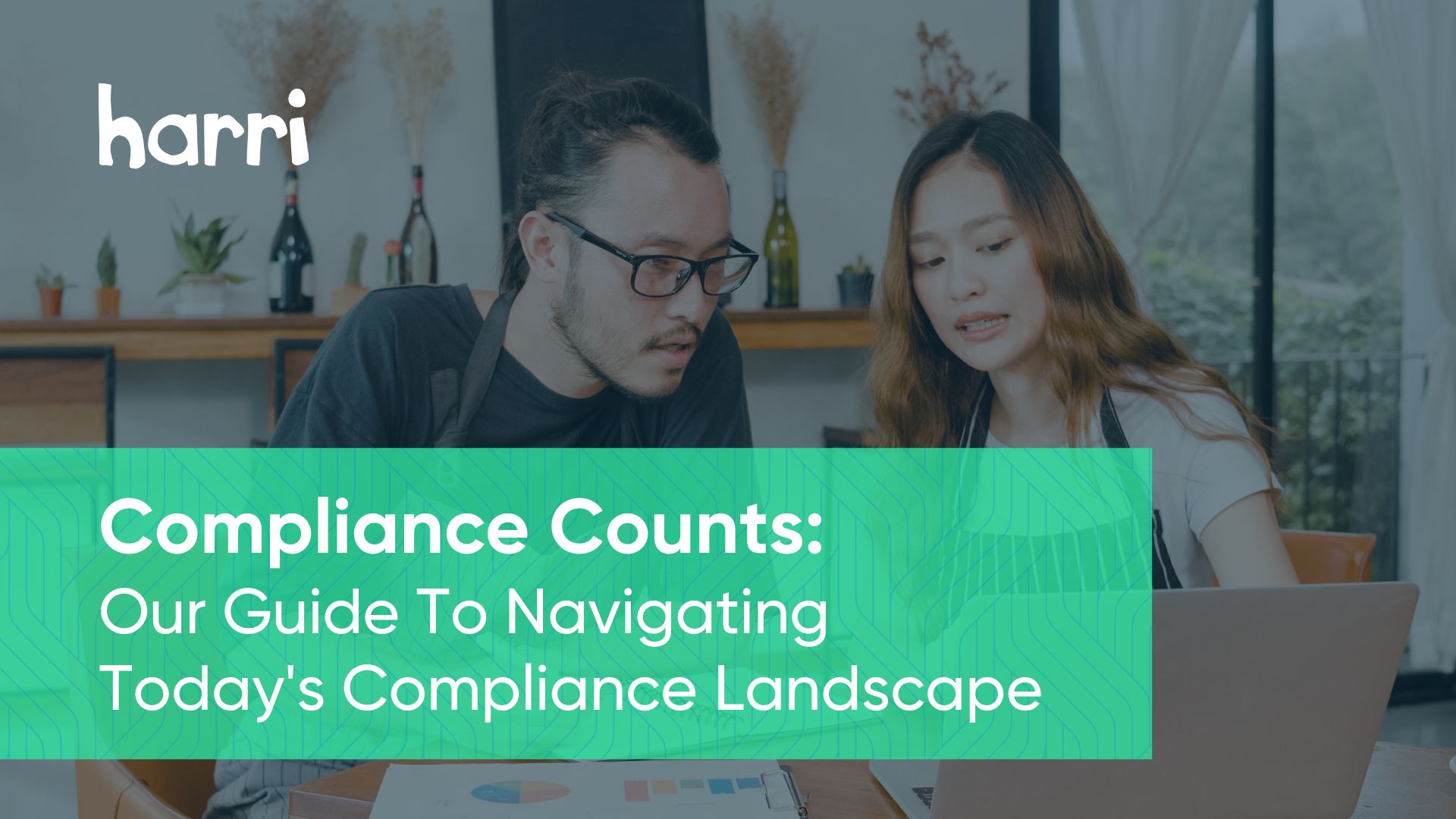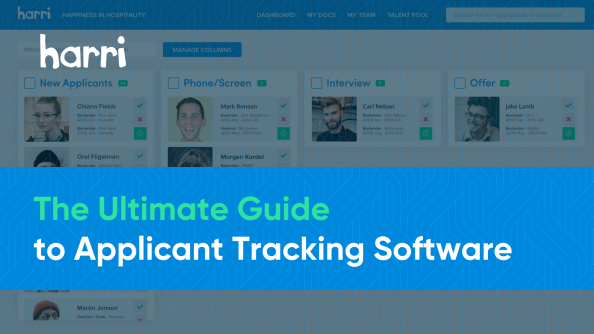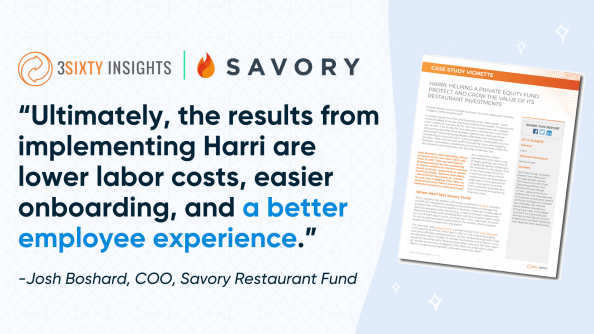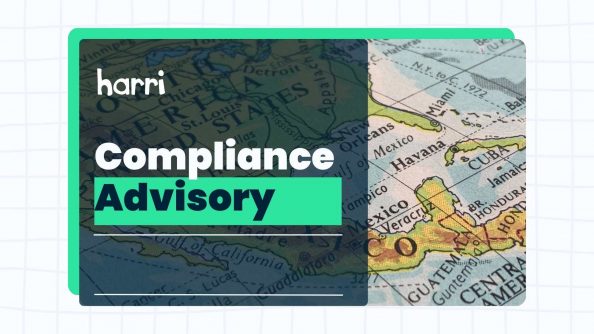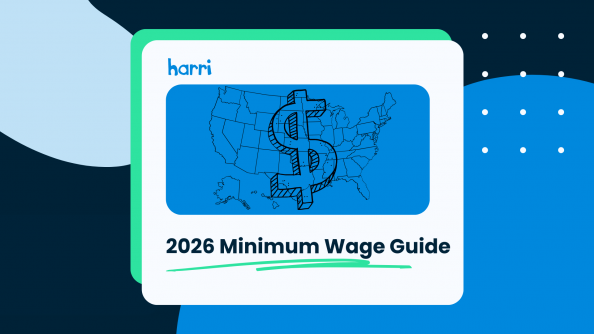Your Cheat Sheet to Cut Through Compliance Complexity

- By Harri Insider Team | June 15, 2023
Compliance counts, but how do you stay proactive when the list of laws, resources, and regulations is constantly changing and growing? Even the most organized and experienced HR professionals need a more straightforward approach to handle the evolving compliance and regulatory landscape. Harri has outlined how to cut through the complexity of compliance and confidently and proactively focus on everyday operations.
Use the below information to :
- Understand compliance in the current HR landscape
- Breakdown compliance by hiring process phase
- Review the latest multi-layered laws at the Federal, state, and local levels.
The Modern HR Compliance Definition
Compliance requires ongoing monitoring and swift responses to the labor laws and regulations implemented on the federal, state, and local levels. It is best practice for HR teams to regularly review compliance requirements and associated best practices. Doing so will help employers avoid infractions, lawsuits, and fines.
Employers are encouraged to review the information shared below and identify which laws and requirements are applicable to their workplace. Each employer is responsible for developing policies and procedures that meet the needs of their workplace and ensure compliance.
The Vast World of Employment Compliance
The following list details regulated areas of employment. This indicates the wide reach of your strategy to combat non-compliance risks and sheds light on the team members that play a part in your proactive approach.
- Americans with Disabilities Act (ADA)
- AI-assisted hires
- Advertisements and Equal Employment Opportunity (EEO)
- Background checks and Fair Credit Reporting Act (FCRA)
- Ban the box
- Diversity
- Drug tests
- Failure to hire
- Interviewers/interview questions
- Job descriptions
- Negligent hires
- Remote work
- Selection
- Wage transparency
- Enrollment forms
- Employee handbook
- I-9 compliance
- ID/badge
- New hire reports
- Payroll
- Policies/procedures
- State-required notifications
- Technology use
- Tax forms
- Americans with Disabilities Act (ADA)
- The Age Discrimination in Employment Act of 1967 (ADEA)
- Manager training
- Negligent training
- Occupational Safety and Health Administration (OSHA)
- Performance management (negligent retention)
- Required training (e.g., data security, active shooters, etc.)
- State-specific rules (e.g., D.C. tipped employee rule)
- Title VII (discrimination/harassment)
- Compensation (pay equity)
- Employee achievement awards (tax implications)
- 401k/The Employee Retirement Income Security Act of 1974 (ERISA) requirements
- Incentive structure (discretionary v. non-discretionary)
- Negligent retention
- Safety achievement awards
- Training & development
- Career paths
- Access to personnel files
- Continuation of Health Coverage (COBRA)
- Communication (team, customers, etc.)
- Company property
- Final paycheck
- Non-compete
- Performance documentation
- Record retention
- Reference checks
- Reductions in Force (RIF)
- Severance (NLRB no non-disparagement)
- Termination letters
- Unemployment benefits
- Vacation payout

Geographic Layers of Compliance Laws
The size of your organization and the geographic regions you operate in will guide the regulations you should be aware of and comply with.
Federal Compliance
Please review the following list of federal labor rules to better understand their applicability in your workplace.
- Affordable Care Act (ACA)
- Americans with Disabilities Act (ADA)
- The Age Discrimination in Employment Act of 1967 (ADEA)
- Equal Employment Opportunity (EEO)
- The Employee Retirement Income Security Act of 1974 (ERISA)
- Fair Credit Reporting Act (FCRA)
- Fair Labor Standards Act (FLSA)
- Family and Medical Leave Act (FMLA)
- The Genetic Information Nondiscrimination Act of 2008 (GINA)
- Health Insurance Portability and Accountability Act (HIPAA)
- National Labor Relations Act (NLRA)
- Occupational Safety and Health Administration (OSHA)
- Older Workers Benefit Protection Act (OWBPA)
- Pregnancy Discrimination Act (PDA)
- Title VII
- Uniformed Services Employment and Reemployment Rights Act (USERRA)
- The Worker Adjustment and Retraining Notification (WARN
State Compliance
The following list details components of state labor law. These components are non-standardized and will vary by state. Please review your state’s labor laws to better understand how to ensure compliance.
- Backgrounds
- Ban the Box
- Bereavement
- Child labor
- Day of rest
- Deductions
- Direct deposit
- Drug testing
- Exemptions
- Fair Workweek
- Final paychecks
- Holiday pay
- Jury duty
- Labor posters
- Meeting time
- Meals & breaks
- Minor Laws
- On-call pay
- Overtime
- Pay cards
- Pay frequency
- Pay stubs
- Privacy
- Record retention
- Reporting time
- Salary history
- Severance
- Sick Leave
- Sleeping time
- Split Shifts
- Minimum wage
- Tips and pooling
- Travel Time
- Uniforms
- Vacation leave
- Voting leave
- Wage deductions
- Wage transparency
- Waiting time workweek
Local Compliance
Local regulations may require the implementation of additional compliance requirements for your workplace. It is recommended to continuously engage with your local governing body to best understand what action is needed as an employer to ensure compliance.
Refer to the following resources for more information:
- Local chambers of commerce
- City, county, or township websites
- Local SHRM chapter
6 Best Practices to Cut Through Compliance
- Stay up-to-date on regulatory changes: Designate a resource to monitor federal, state, and local regulatory sources for changes, and update processes accordingly.
- Establish clear policies and procedures: Determine the compliance areas of focus for your business and assign project owners to complete training, provide regular communication updates, and support the development of a compliance manual.
- Understand requirements and resources: With the assistance of legal counsel, Identify possible compliance gaps.
- Conduct regular compliance self-audits: Establish a regular cadence of internal audits and review any vulnerabilities to be reported to stakeholders. Corrective action should be taken when nonconformity is discovered.
- Foster a positive compliance culture: Train employees and managers to lead by example. Communicate about compliance often and support a workplace environment that rewards and recognizes successful compliance practices.
- Identify technology built for compliance management: Implement technology in your workspace designed to assist managers and employers with compliance best practices.
You can use our handy checklist here, or learn how to create your own compliance checklist specific to the hospitality industry with our full guide.
Navigate Compliance with Harri
Harri’s all-in-one workforce compliance management system helps hospitality organizations navigate the complicated compliance landscape and achieve better business outcomes.
Harri assists employers with identifying gaps in their processes, streamlining their operations, and cultivating an environment where employees are successful. Harri continuously updates its platform to improve the user experience and meet changing compliance requirements.
Want to learn more about Harri Workforce Management? Chat with our team today to learn how our unparalleled employer and employee experience drives business performance for over 20,000 restaurant locations globally.

